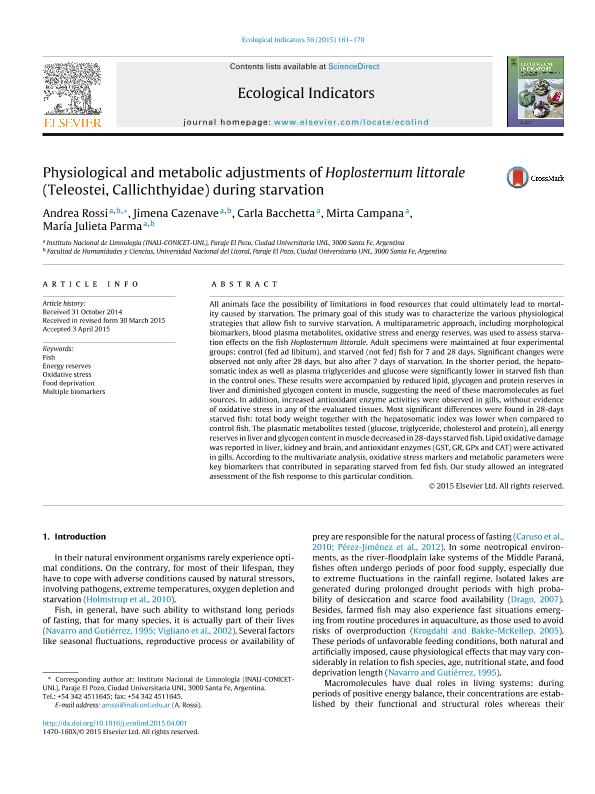Mostrar el registro sencillo del ítem
dc.contributor.author
Rossi, Andrea Silvana

dc.contributor.author
Cazenave, Jimena

dc.contributor.author
Bacchetta, Carla

dc.contributor.author
Campana, Mirta Claudia

dc.contributor.author
Parma, Maria Julieta E.

dc.date.available
2018-06-29T19:23:22Z
dc.date.issued
2015-09
dc.identifier.citation
Rossi, Andrea Silvana; Cazenave, Jimena; Bacchetta, Carla; Campana, Mirta Claudia; Parma, Maria Julieta E.; Physiological and metabolic adjustments of Hoplosternum littorale (Teleostei, Callichthyidae) during starvation; Elsevier Science; Ecological Indicators; 56; 9-2015; 161-170
dc.identifier.issn
1470-160X
dc.identifier.uri
http://hdl.handle.net/11336/50777
dc.description.abstract
All animals face the possibility of limitations in food resources that could ultimately lead to mortality caused by starvation. The primary goal of this study was to characterize the various physiological strategies that allow fish to survive starvation. A multiparametric approach, including morphological biomarkers, blood plasma metabolites, oxidative stress and energy reserves, was used to assess starvation effects on the fish Hoplosternum littorale. Adult specimens were maintained at four experimental groups: control (fed ad libitum), and starved (not fed) fish for 7 and 28 days. Significant changes were observed not only after 28 days, but also after 7 days of starvation. In the shorter period, the hepatosomatic index as well as plasma triglycerides and glucose were significantly lower in starved fish than in the control ones. These results were accompanied by reduced lipid, glycogen and protein reserves in liver and diminished glycogen content in muscle, suggesting the need of these macromolecules as fuel sources. In addition, increased antioxidant enzyme activities were observed in gills, without evidence of oxidative stress in any of the evaluated tissues. Most significant differences were found in 28-days starved fish: total body weight together with the hepatosomatic index was lower when compared to control fish. The plasmatic metabolites tested (glucose, triglyceride, cholesterol and protein), all energy reserves in liver and glycogen content in muscle decreased in 28-days starved fish. Lipid oxidative damage was reported in liver, kidney and brain, and antioxidant enzymes (GST, GR, GPx and CAT) were activated in gills. According to the multivariate analysis, oxidative stress markers and metabolic parameters were key biomarkers that contributed in separating starved from fed fish. Our study allowed an integrated assessment of the fish response to this particular condition.
dc.format
application/pdf
dc.language.iso
eng
dc.publisher
Elsevier Science

dc.rights
info:eu-repo/semantics/openAccess
dc.rights.uri
https://creativecommons.org/licenses/by-nc-nd/2.5/ar/
dc.subject
Energy Reserves
dc.subject
Fish
dc.subject
Food Deprivation
dc.subject
Multiple Biomarkers
dc.subject
Oxidative Stress
dc.subject.classification
Otras Ciencias Biológicas

dc.subject.classification
Ciencias Biológicas

dc.subject.classification
CIENCIAS NATURALES Y EXACTAS

dc.title
Physiological and metabolic adjustments of Hoplosternum littorale (Teleostei, Callichthyidae) during starvation
dc.type
info:eu-repo/semantics/article
dc.type
info:ar-repo/semantics/artículo
dc.type
info:eu-repo/semantics/publishedVersion
dc.date.updated
2018-06-29T12:57:41Z
dc.journal.volume
56
dc.journal.pagination
161-170
dc.journal.pais
Países Bajos

dc.journal.ciudad
Amsterdam
dc.description.fil
Fil: Rossi, Andrea Silvana. Consejo Nacional de Investigaciones Científicas y Técnicas. Centro Científico Tecnológico Conicet - Santa Fe. Instituto Nacional de Limnología. Universidad Nacional del Litoral. Instituto Nacional de Limnología; Argentina. Universidad Nacional del Litoral. Facultad de Humanidades y Ciencias; Argentina
dc.description.fil
Fil: Cazenave, Jimena. Consejo Nacional de Investigaciones Científicas y Técnicas. Centro Científico Tecnológico Conicet - Santa Fe. Instituto Nacional de Limnología. Universidad Nacional del Litoral. Instituto Nacional de Limnología; Argentina. Universidad Nacional del Litoral. Facultad de Humanidades y Ciencias; Argentina
dc.description.fil
Fil: Bacchetta, Carla. Consejo Nacional de Investigaciones Científicas y Técnicas. Centro Científico Tecnológico Conicet - Santa Fe. Instituto Nacional de Limnología. Universidad Nacional del Litoral. Instituto Nacional de Limnología; Argentina
dc.description.fil
Fil: Campana, Mirta Claudia. Consejo Nacional de Investigaciones Científicas y Técnicas. Centro Científico Tecnológico Conicet - Santa Fe. Instituto Nacional de Limnología. Universidad Nacional del Litoral. Instituto Nacional de Limnología; Argentina
dc.description.fil
Fil: Parma, Maria Julieta E.. Consejo Nacional de Investigaciones Científicas y Técnicas. Centro Científico Tecnológico Conicet - Santa Fe. Instituto Nacional de Limnología. Universidad Nacional del Litoral. Instituto Nacional de Limnología; Argentina. Universidad Nacional del Litoral. Facultad de Humanidades y Ciencias; Argentina
dc.journal.title
Ecological Indicators

dc.relation.alternativeid
info:eu-repo/semantics/altIdentifier/doi/https://dx.doi.org/10.1016/j.ecolind.2015.04.001
dc.relation.alternativeid
info:eu-repo/semantics/altIdentifier/url/https://www.sciencedirect.com/science/article/pii/S1470160X15001727
Archivos asociados
